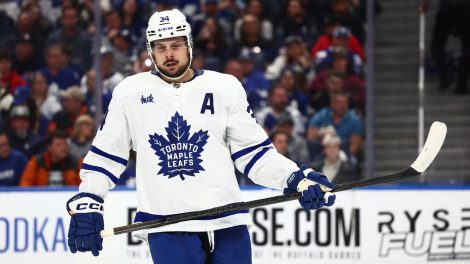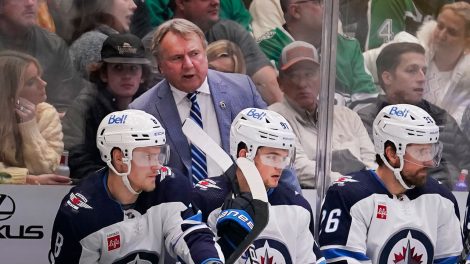If you monitor a full slate of NHL games on any given night, chances are you’ll run into a contentious goal review that will divide opinion. The problem is with the inconsistency in which goaltender interference is called and that no one seems to know for sure what constitutes a good goal, and what should be overturned.
It’s the NHL’s version of the NFL’s blurry catch rule.
Just prior to the all-star break there were a pair of rulings against two of the NHL’s best young stars, who then showed their own boiled-over emotion after they scored later on. There was Auston Matthews and his goal-signal celebration (mimicked by Jack Eichel at all-star) and Connor McDavid mouthing “go upstairs” to the referee. It was a major talking point over all-star weekend in Tampa Bay.
“Overall the system works, but I think we’ve gotten to the point where everybody’s overthinking the review,” Bettman said during all-star weekend. “The intention, particularly on goaltender interference, is did you miss something? I think the consensus of the meeting was really more we need to give a refresher – and we’re going to send a memo to the officials: ‘Take a quick look, but don’t search it to death.’
“The presumption should be the call on the ice was good unless you have a good reason to overturn it. And you shouldn’t have to search for a good reason.”
On the third night back from the break, goalie interference reviews were again in the spotlight as players, coaches and fans were frustrated over a few examples Thursday night. Mark Spector touched on the ridiculousness of the review process in Edmonton, in which the refs reviewed it once to see if the puck crossed the line and then ruled it a good goal, but needed to be challenged by Avs coach Jared Bednar to check for interference. After a second review, the goal was rightly called back.
But that was only the tip of the iceberg.
Winnipeg Jets captain Blake Wheeler was livid after a Vegas Golden Knights goal stood, despite the fact James Neal whacked Connor Hellebuyck on the mask with his stick.
“The explanation was that the puck was behind the goalie, which gives their player the right to break his stick over his head,” Wheeler said post-game. “There’s been an outcry with the league to try to get this right. We were told before the game that it was going to be a little bit cleaner and they weren’t going to be looking for goalie interference. First time I’ve seen a guy break his stick over the goalie’s head.
“Now it’s bad. It was bad before but now … c’mon. [Expletive] breaks his stick over his head, it’s not a goal. I don’t care where the puck is.”
Blake Wheeler on tonight's close game. #VGKvsWPG pic.twitter.com/LLKFP4RPbO
— Winnipeg Jets (@NHLJets) February 2, 2018
This incident happened in the last two minutes of the second period when the game was 1-1. The Golden Knights went on to win in overtime, so the ruling had a massive impact on the game.
There was another incident in Boston as well.
The Bruins opened the scoring nearly 13 minutes into the game, but it was challenged by the Blues because two Boston players crashed into the crease. The most relevant offender here is rookie Jake DeBrusk, who actually falls in the crease (not pushed) and appears to make content with Blues goalie Jake Allen, who is nudged out of the crease and out of the play.
The St. Louis defencemen couldn’t clear the puck on the goal line and the Bruins put it in. Good goal.
According to reporters, the Blues were told this was not interference because Allen did not fight his way back, and had no chance to make the save anyway. On that point, Blues GM Doug Armstrong sounded off to The Athletic’s Jeremy Rutherford.
Allen was more diplomatic, but hit on a point many fans are thinking whenever plays are controversially upheld or overturned. Will this grey area on goalie interference eventually lead us back to a Brett Hull moment in the playoffs, when it determines the winner and loser of a game or series?
“It’s a tough area to call,” Allen said. “It puts the refs in a tough spot. The game’s so fast. The game’s so quick. To be honest, they probably don’t have time to see everything on the ice either.
“I hope at some point during the year, it doesn’t blow a playoff or something like that. That’s the unfortunate part. It’s tough to comment on it to be honest.”
Boston’s David Backes joined Hockey Central at Noon on Friday, and though he was on the right side of this ruling, he wasn’t sure it would count when he saw it.
“Once they challenged it and I saw the replay with maybe a slide tackle, maybe a box out of the goalie and a tap in on the other side, I was not real certain we were going to have a 1-0 lead after they were done reviewing it,” he said.
Finally, in Los Angeles, a Nashville goal was overturned, though there wasn’t much outrage over this one for two reasons. One, it was a 5-0 Predators win anyway, so it wasn’t a big factor. And, two, Kings defenceman Drew Doughty was pushed into the crease, so there’s a reasonable argument to be made for interference. The frustration on this one stems from the force (or lack thereof) of the push, and how much Doughty tried to slow himself or avoid bumping his goalie.
All together, the mess that is the goalie interference rule continues to be a thorn in the NHL’s side, and though the league is attempting to tighten the rule and shorten the length of time it takes to review, the first post-all-star wave of these hasn’t gotten any better. It’s a work in progress that no one has an obvious solution for, so it will continue to be a source of frustration for everyone.
Backes explained how he views the goalie interference calls and echoed the sentiment most have on the process as currently constituted.
“With all of them that happened throughout the league on a nightly basis this is becoming a running joke I think at some point,” Backes said. “I don’t know what the solution is necessarily. When they go your favour you love it, when they go against you, you wonder what the heck’s going on and you try to get new definitions of the rule every time.
“The definition or the help I was given is that if it’s in the blue paint the goaltender’s going to get the benefit of the doubt more often than not. And if it’s outside of the blue paint, that’s the player’s area and the player will get the benefit of the doubt.
“For the majority of them, if you look at it that way that’s kind of the way it’s fallen, but there’s the anomaly or special examination of the rule where you kinda just go, I’m not sure.”
[relatedlinks]









